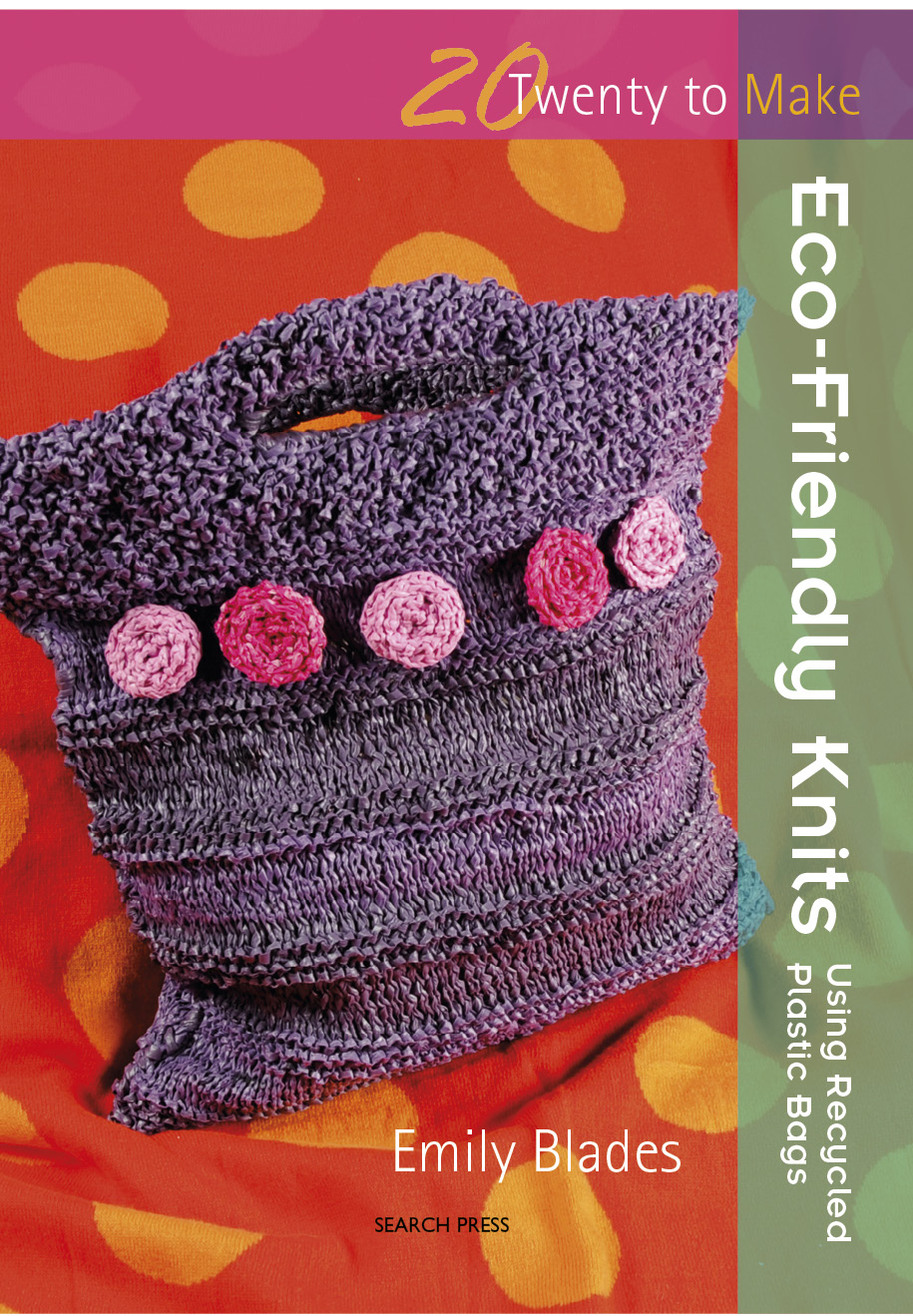

Emily Blades parents main interests were arts, crafts and literature, and like many creative people, they educated their daughter at home. Art galleries, Craft Council exhibitions and the freedom to pursue whatever interested her at the time allowed Emily to develop her own creative side. She has taught gymnastics to the under-5s, worked as a nanny, enjoys drawing, reading, walking, visiting galleries and museums and, of course, knitting!

First published in Great Britain 2010 Search Press Limited
Wellwood, North Farm Road,
Tunbridge Wells, Kent TN2 3DR Text copyright Emily Blades 2010 Photographs by Debbie Patterson at Search Press studios Photographs and design copyright Search Press Ltd 2010 All rights reserved. No part of this book, text, photographs or illustrations may be reproduced or transmitted in any form or by any means by print, photoprint, microfilm, microfiche, photocopier, internet or in any way known or as yet unknown, or stored in a retrieval system, without written permission obtained beforehand from Search Press. Print ISBN: 978-1-84448-486-7 EPUB ISBN: 978-1-78126-019-7 Kindle ISBN: 978-1-78126-074-6 PDF ISBN: 978-1-78126-128-6 The Publishers and author can accept no responsibility for any consequences arising from the information, advice or instructions given in this publication. Readers are permitted to reproduce any of the items in this book for their personal use, or for the purposes of selling for charity, free of charge and without the prior permission of the Publishers.
Any use of the items for commercial purposes is not permitted without the prior permission of the Publishers. Suppliers If you have difficulty in obtaining any of the materials and equipment mentioned in this book, then please visit the Search Press website for details of suppliers:
www.searchpress.com
| Dedication For my parents who taught me so well, my husband who supports me in all I do, my darling twins for putting up with my obsession with knitting. And last but not least Gerard Allt for enabling me to believe in myself. |
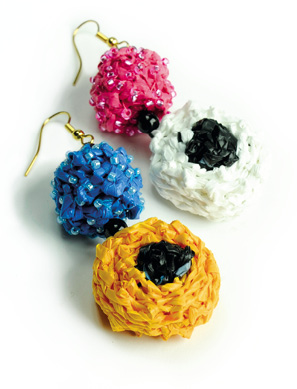
| Abbreviations beg: beginning dec: decrease (by working two stitches together) g st: garter stitch (knit every row) inc: increase (by working into the front and back of the stitch) k: knit k2tog: knit two stitches together p: purl p2tog: purl two stitches together rib: ribbing (one stitch knit, one stitch purl) st(s): stitch(es) st st: stocking stitch (one row knit, one row purl) *-** : Repeat from the point marked * to the point marked ** |

Contents
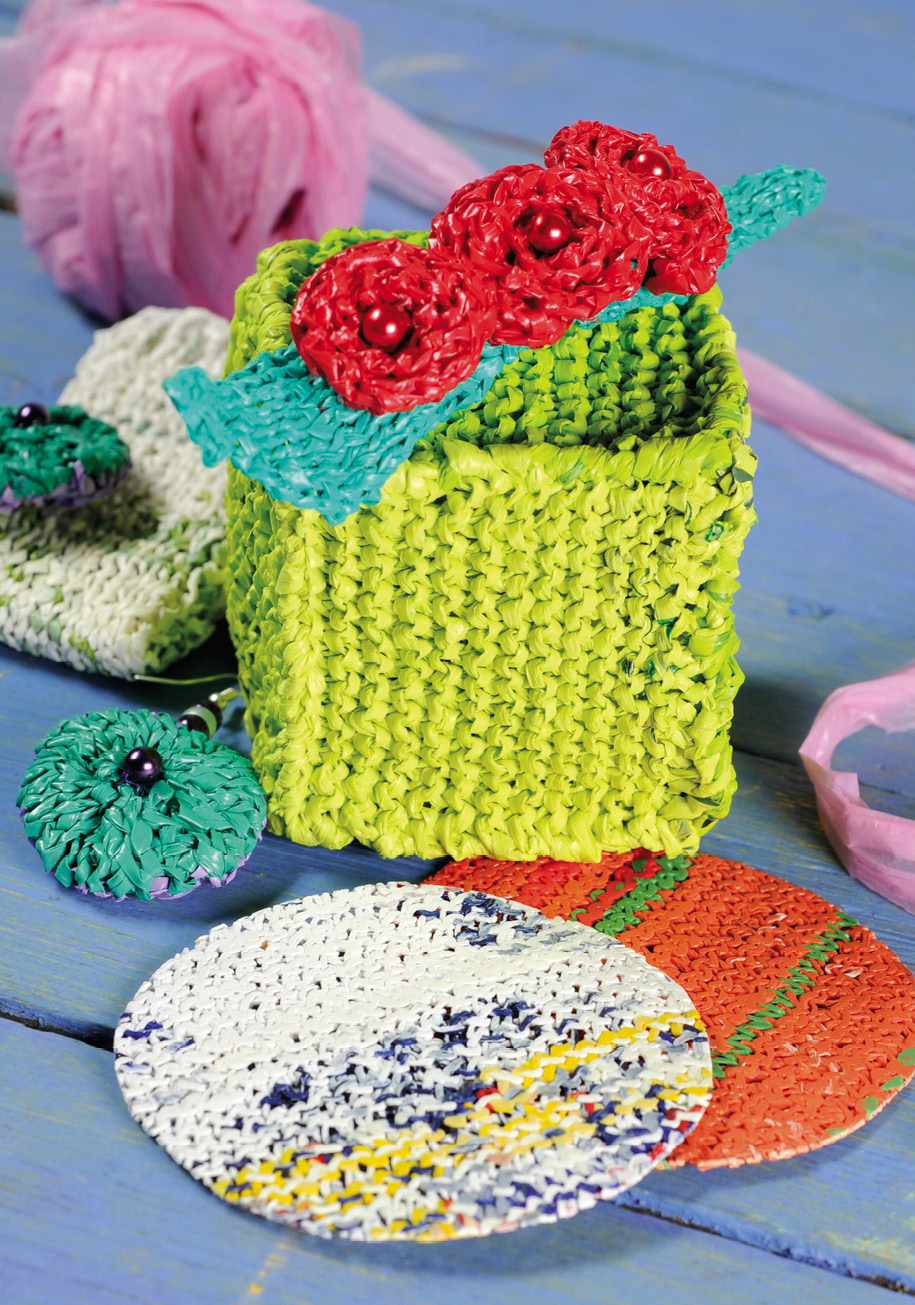
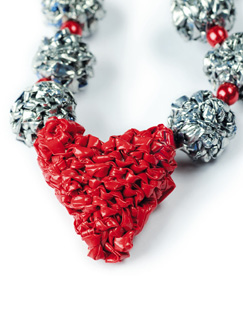
Introduction I am very excited to bring you the first ever book on knitting and recycling, a craft that came about quite by chance for me. After reading about knitting with strips of plastic cut from shopping bags, I was inspired to create unique and desirable objects that are pleasing to look at, useful and also help the environment by cutting down on waste plastic. Throughout this book I refer to the plastic as plarn a combination of the words plastic and yarn.
It is very satisfying to end up with balls of colourful plarn instead of a dustbin full of disused bags! The projects in this book range from beginner to advanced, so whatever your knitting ability you will be sure to find something to make. All the items would make excellent gifts with the smaller ones easily done for those last-minute occasions. I hope you have as much fun knitting them as I have had designing them all! 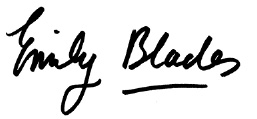
| Preparing Plarn Take a plastic carrier bag and make sure it is clean and dry. Lay the bag out flat and cut off the sealed bottom and handles, leaving you with a cylinder shape. With the openings at the sides, roll and fold the bag up to 3cm (1in) from the top. Use scissors to cut the folded part (and only the folded part) into strips approximately 2cm (1in) wide. This will then knit up to an approximate double knit tension. The thinnest, flimsiest bags should be cut into wider strips of 4cm (1in), and the heaviest, most glossy bags should be trimmed into narrower 1cm (in) strips for the same tension. The thinner bags are easier to work with, so I recommend that you use them when you start out. Unfold the bag and you will have a number of single strips hanging from the uncut part of the bag. Open the bag out and cut diagonally from the outside edge of the bag to the first inside cut. Continue cutting diagonally until all the strips are separated. You should now have one long continuous strip of plastic. Roll this up into a ball. You now have a ball of plarn that is ready to be knitted up. Plastic bags of one colour will let you make items with solid colour, but you can make variegated plarn from striped or patterned bags. |
Mobile Phone Sock
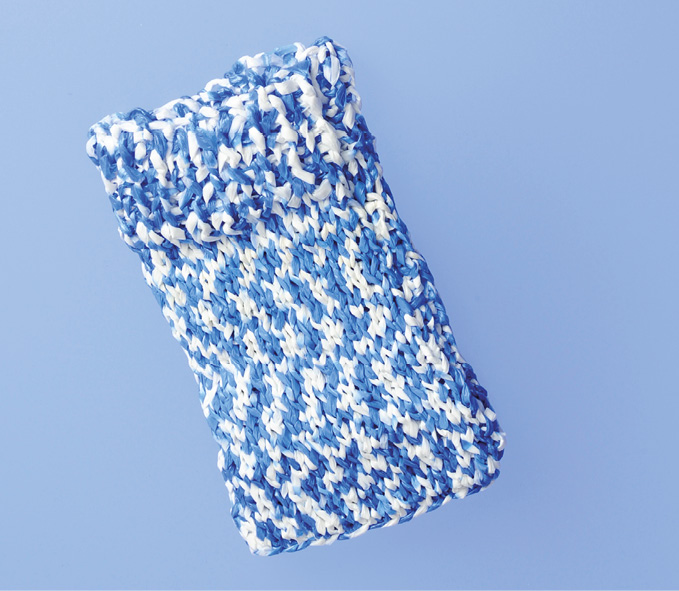
Materials: Plarn in variegated blue and white five very thin carrier bags Large darning needle Needles: 1 pair 4mm (UK 8; US 6) knitting needles
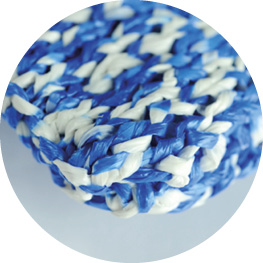
Instructions: Knitting Cast on 40st and knit in k1, p1 rib for 8 rows. Cast off. Cast off.
Making up Sew in any unwanted ends then fold the work in half, with the wrong side on the outside. Thread some spare plarn on to your darning needle and stitch together the sides and bottom of the sock (see detail above). Turn the piece the right way out and your mobile sock is ready to use.  Tweed Look Those flimsy, striped bags from the corner shop are ideal for this project.
Tweed Look Those flimsy, striped bags from the corner shop are ideal for this project.
Purse
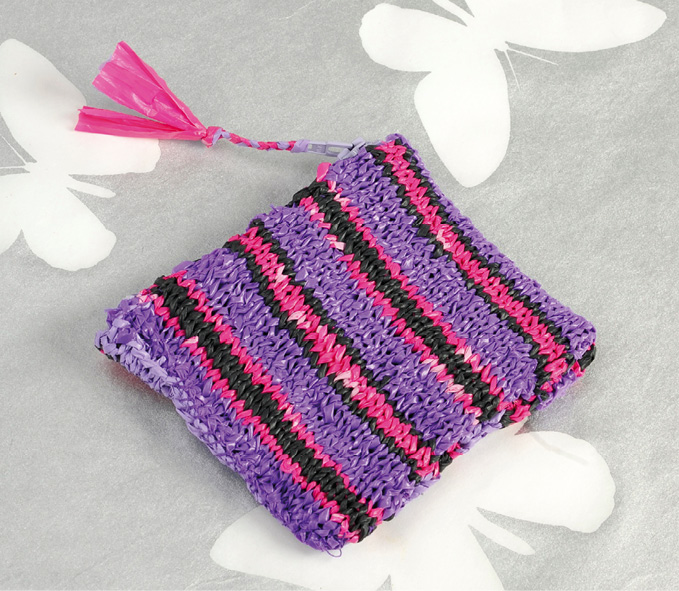
Materials: Plarn in purple, pink and black approximately one carrier bag of each colour Large darning needle Sewing needle and thread A 10cm (4in) zip Needles: 1 pair 3.75mm (UK 9; US 5) knitting needles
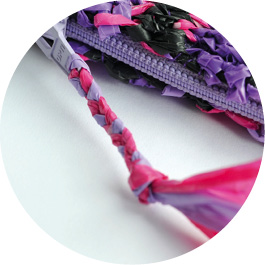
Instructions: Work in stocking stitch throughout. Knitting Cast on 25st.



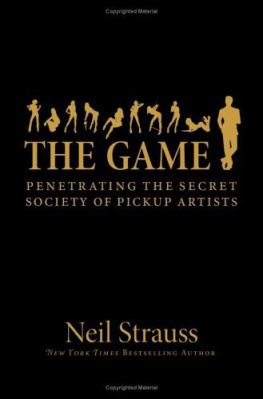
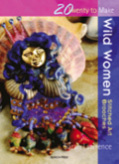

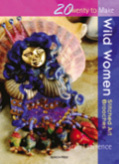
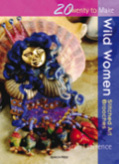
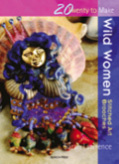


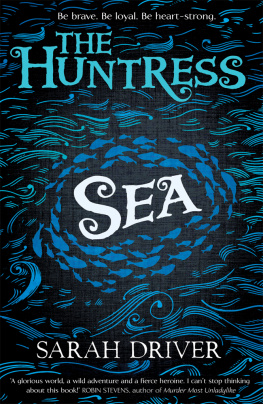
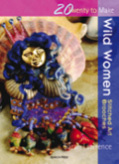

 Emily Blades parents main interests were arts, crafts and literature, and like many creative people, they educated their daughter at home. Art galleries, Craft Council exhibitions and the freedom to pursue whatever interested her at the time allowed Emily to develop her own creative side. She has taught gymnastics to the under-5s, worked as a nanny, enjoys drawing, reading, walking, visiting galleries and museums and, of course, knitting!
Emily Blades parents main interests were arts, crafts and literature, and like many creative people, they educated their daughter at home. Art galleries, Craft Council exhibitions and the freedom to pursue whatever interested her at the time allowed Emily to develop her own creative side. She has taught gymnastics to the under-5s, worked as a nanny, enjoys drawing, reading, walking, visiting galleries and museums and, of course, knitting!  First published in Great Britain 2010 Search Press Limited
First published in Great Britain 2010 Search Press Limited
 Contents
Contents 
 Introduction I am very excited to bring you the first ever book on knitting and recycling, a craft that came about quite by chance for me. After reading about knitting with strips of plastic cut from shopping bags, I was inspired to create unique and desirable objects that are pleasing to look at, useful and also help the environment by cutting down on waste plastic. Throughout this book I refer to the plastic as plarn a combination of the words plastic and yarn.
Introduction I am very excited to bring you the first ever book on knitting and recycling, a craft that came about quite by chance for me. After reading about knitting with strips of plastic cut from shopping bags, I was inspired to create unique and desirable objects that are pleasing to look at, useful and also help the environment by cutting down on waste plastic. Throughout this book I refer to the plastic as plarn a combination of the words plastic and yarn. 
 Materials: Plarn in variegated blue and white five very thin carrier bags Large darning needle Needles: 1 pair 4mm (UK 8; US 6) knitting needles
Materials: Plarn in variegated blue and white five very thin carrier bags Large darning needle Needles: 1 pair 4mm (UK 8; US 6) knitting needles  Instructions: Knitting Cast on 40st and knit in k1, p1 rib for 8 rows. Cast off. Cast off.
Instructions: Knitting Cast on 40st and knit in k1, p1 rib for 8 rows. Cast off. Cast off.  Tweed Look Those flimsy, striped bags from the corner shop are ideal for this project.
Tweed Look Those flimsy, striped bags from the corner shop are ideal for this project. Materials: Plarn in purple, pink and black approximately one carrier bag of each colour Large darning needle Sewing needle and thread A 10cm (4in) zip Needles: 1 pair 3.75mm (UK 9; US 5) knitting needles
Materials: Plarn in purple, pink and black approximately one carrier bag of each colour Large darning needle Sewing needle and thread A 10cm (4in) zip Needles: 1 pair 3.75mm (UK 9; US 5) knitting needles  Instructions: Work in stocking stitch throughout. Knitting Cast on 25st.
Instructions: Work in stocking stitch throughout. Knitting Cast on 25st.